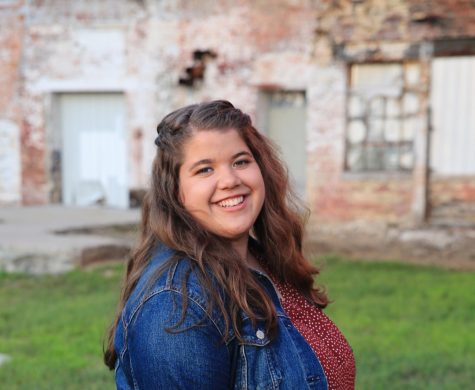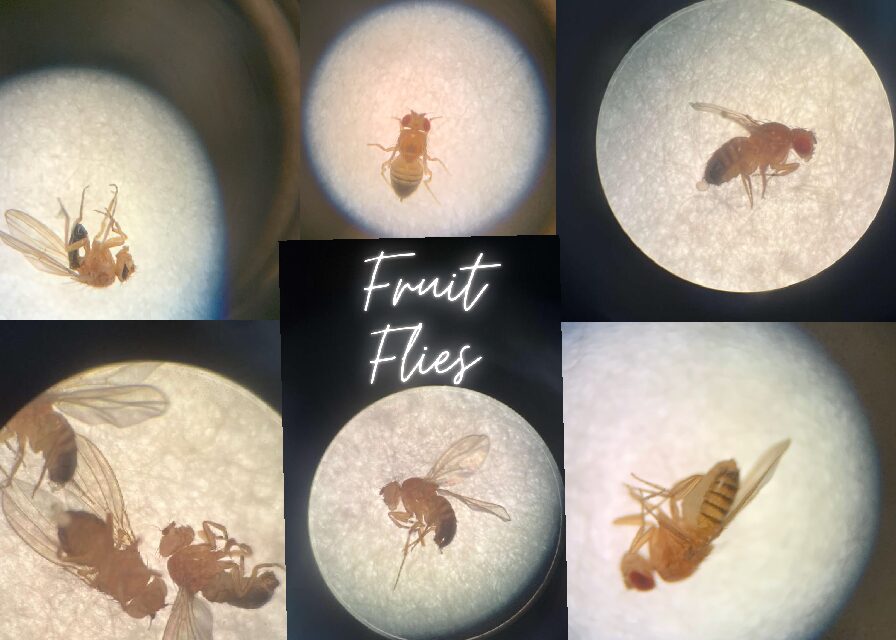AP Biology students are flying to new levels of dedication

More stories from Lauren Brace
Ella Satterthwaite and Chris Shang
A collection of fruit fly images from Ella Satterthwaite and Chris Shang
When senior Ella Satterthwaite went to check on her AP Biology project, she was surprised to see that it had mysteriously disappeared. Ella and her lab partner, senior Desiree Tuohy, had just embarked on their newest experiment: crossbreeding fruit flies. However, they were nowhere to be found in the classroom.
“One time, I had to go home after school,” Ella said, “and [I thought I’d] go and check on the flies really quickly. I go in there, and there’s no vial. I text Desiree; she has it on her. She’d been incubating it the whole day, watching over our flies. That’s the amount of dedication she brings to the table. She’s a true fly mama.”
From experiments with yeast to studying natural selection at the zoo, student dedication in AP Biology is unparalleled, especially when it comes to their fruit fly lab.
In the months leading up to spring break, it isn’t uncommon to see students bringing their vials of flies to each class—ensuring that everything goes smoothly with each group.
“She even is so dedicated that she used to take them around with her,” Ella said, remarking on the efforts of her partner Desiree. “If a vial wasn’t doing so hot, she would take it around with her to each of her classes and keep it in her pocket. [She was] like a mother bird almost. She would incubate the flies as that does actually help them grow up quicker and healthier.”
These strategies are an asset to each group that hopes to prevent unwanted bacteria from growing and jeopardizing the experiment. Towards their goal of separating two breeds of drosophila flies, the steps require patience and precision with paintbrushes; students don’t have the luxury of just winging it. Through the experiment, they will observe how each gene is passed on with inheritance patterns to create their hybrid generations.
Later on, the biology students will run statistical tests to see the probability of inherited traits and how closely their predictions match the end results. Each group gets to choose the two distinct characteristics that they want to breed, and it’s another key strategy to choose features that will be easy to distinguish from one another.
“[We picked the traits] that would be easier to identify males and females and [would] make it easier to see if the traits are present,” junior Chris Shang said. “For some, it’s eye color; it might be harder to see the color of the eye. But then for vestigial wings, it’s really obvious if it’s a big wing or a small wing, so I can make it easier on myself.”
After isolating two fly mutations, the students are tasked with several time-sensitive steps, including isolating virgin females and even putting the insects to sleep. This process allows students to put the flies in a petri dish and view specific traits up close with a microscope.
Although it may be frustrating when students don’t get the results they expect, this is just another test of their perseverance and dedication. Many students come into one of the AP Biology classrooms—run by teachers Kristy Butler and Patti Richardson—before or after school to check in on their drosophila or get a head start on the next phase.
“[The flies are] pretty time-sensitive, depending on what part of the project they are doing,” Butler said, “so they have to do the right timing where they’re extracting flies. Sometimes, they have to come in in the morning and release adult flies and sometimes stay after school to look at their flies after they have napped them. It depends on where they are in the process; the timing can be specific.”
While it’s an advantage to be able to work outside of class time, this lab is also unique in its length. The lab spans a couple of months, and sometimes even longer, as two hybrid generations can’t be formed over merely a few days. This aspect provides a more realistic experience by providing an example of what future labs in a professional career would entail.
“It gives students a really good real-world experience,” Butler said. “It’s not just like we do science in an hour in the lab and then you’re done. It’s definitely an endurance lab, but it’s pretty cool once you’re all said and done with it.”
For students like Ella and Chris, these labs provide the perfect opportunity for hands-on and insightful experiments. The genetics unit is extremely rich in knowledge and will prove to especially benefit students hoping to pursue a career in the medical field.
“There are procedures that we use that will likely be used in the professional field, too,” Chris said. “A lot of the stuff we do in the class and the lab are actual procedures that scientists use for research, so it’s always good to have some experience before going into college or another lab.”
Instead of merely taking notes and listening to lectures, every lab in AP Biology allows students to fully immerse themselves in science. Overall, it provides the perfect exposure for students to be proud of their own discoveries and accomplishments.
“You don’t truly appreciate it when it says [that] a scientist took literally five years of studying flies or five years studying some other insect in a lab,” Ella said. “You don’t appreciate how hard that is until you’ve done it; you have such an admiration and respect for people who have committed their lives to study flies for the advancement of science.”

Lauren is a senior entering her final year on The Central Trend as Podcast Manager. She has a strong passion for every extracurricular she's involved in,...



























































































